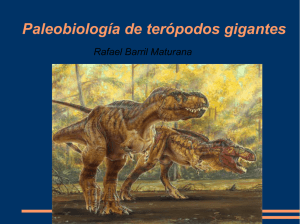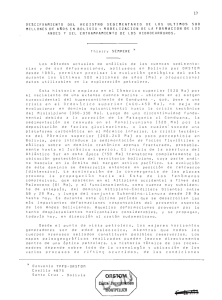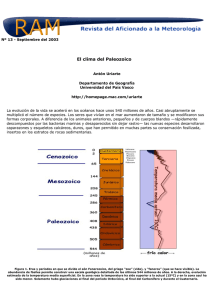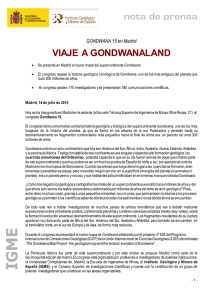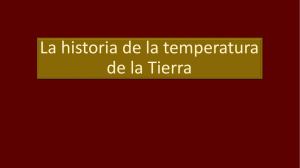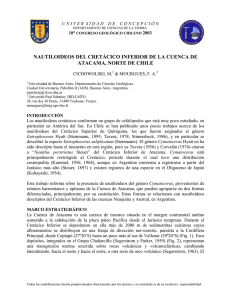Estudio palinológico del Cretácico inferior de la Cuenca de San Luis
Anuncio
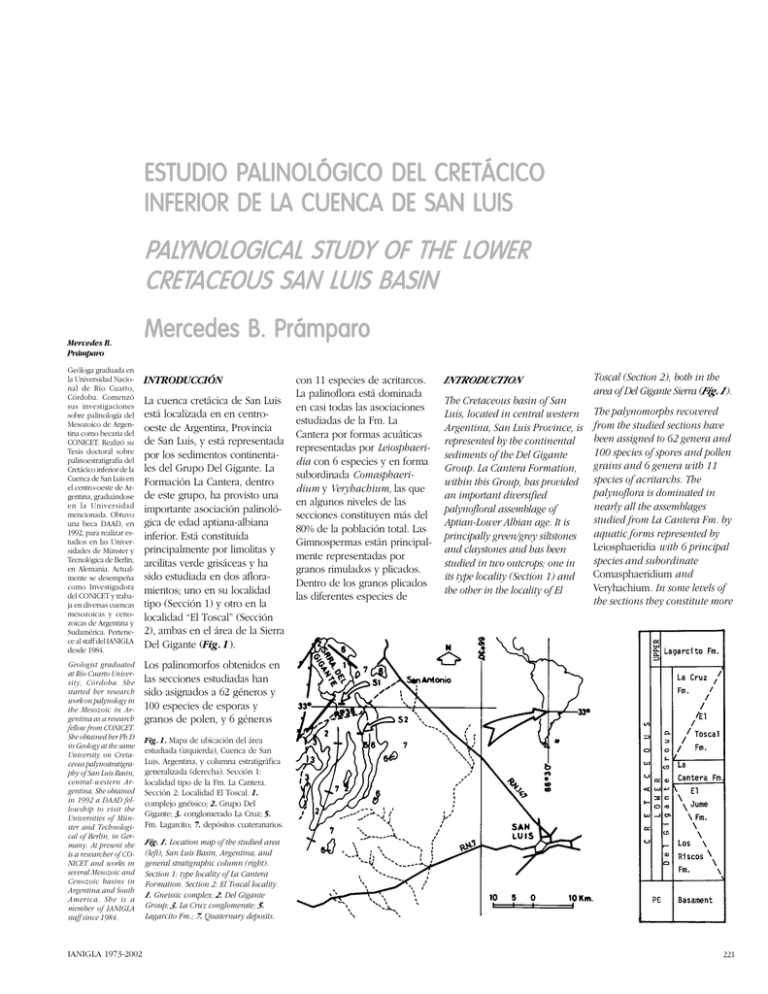
ESTUDIO PPALINOL ALINOL ÓGICO DEL CRET Á CICO ALINOLÓ CRETÁ INFERIOR DE LA CUENCA DE SAN LUIS PAL YNOLOGICAL STUDY OF THE LOWER ALYNOLOGICAL CRET ACEOUS SAN LUIS BASIN CRETACEOUS Mercedes B. Prámparo Geóloga graduada en la Universidad Nacional de Río Cuarto, Córdoba. Comenzó sus investigaciones sobre palinología del Mesozoico de Argentina como becaria del CONICET. Realizó su Tesis doctoral sobre palinoestratigrafía del Cretácico inferior de la Cuenca de San Luis en el centro-oeste de Argentina, graduándose en la Universidad mencionada. Obtuvo una beca DAAD, en 1992, para realizar estudios en las Universidades de Münster y Tecnológica de Berlin, en Alemania. Actualmente se desempeña como Investigadora del CONICET y trabaja en diversas cuencas mesozoicas y cenozoicas de Argentina y Sudamérica. Pertenece al staff del IANIGLA desde 1984. Geologist graduated at Río Cuarto University, Córdoba. She started her research work on palynology in the Mesozoic in Argentina as a research fellow from CONICET. She obtained her Ph.D in Geology at the same University on Cretaceous palynostratigraphy of San Luis Basin, central-western Argentina. She obtained in 1992 a DAAD fellowship to visit the Universities of Münster and Technological of Berlin, in Germany. At present she is a researcher of CONICET and works in several Mesozoic and Cenozoic basins in Argentina and South America. She is a member of IANIGLA staff since 1984. IANIGLA 1973-2002 Mercedes B. Prámparo INTRODUCCIÓN La cuenca cretácica de San Luis está localizada en en centrooeste de Argentina, Provincia de San Luis, y está representada por los sedimentos continentales del Grupo Del Gigante. La Formación La Cantera, dentro de este grupo, ha provisto una importante asociación palinológica de edad aptiana-albiana inferior. Está constituida principalmente por limolitas y arcilitas verde grisáceas y ha sido estudiada en dos afloramientos; uno en su localidad tipo (Sección 1) y otro en la localidad El Toscal (Sección 2), ambas en el área de la Sierra Del Gigante (Fig. 1). con 11 especies de acritarcos. La palinoflora está dominada en casi todas las asociaciones estudiadas de la Fm. La Cantera por formas acuáticas representadas por Leiosphaeridia con 6 especies y en forma subordinada Comasphaeridium y Veryhachium, las que en algunos niveles de las secciones constituyen más del 80% de la población total. Las Gimnospermas están principalmente representadas por granos rimulados y plicados. Dentro de los granos plicados las diferentes especies de INTRODUCTION The Cretaceous basin of San Luis, located in central western Argentina, San Luis Province, is represented by the continental sediments of the Del Gigante Group. La Cantera Formation, within this Group, has provided an important diversified palynofloral assemblage of Aptian-Lower Albian age. It is principally green/grey siltstones and claystones and has been studied in two outcrops; one in its type locality (Section 1) and the other in the locality of El Toscal (Section 2), both in the area of Del Gigante Sierra (Fig. 1). The palynomorphs recovered from the studied sections have been assigned to 62 genera and 100 species of spores and pollen grains and 6 genera with 11 species of acritarchs. The palynoflora is dominated in nearly all the assemblages studied from La Cantera Fm. by aquatic forms represented by Leiosphaeridia with 6 principal species and subordinate Comasphaeridium and Veryhachium. In some levels of the sections they constitute more Los palinomorfos obtenidos en las secciones estudiadas han sido asignados a 62 géneros y 100 especies de esporas y granos de polen, y 6 géneros Fig. 1. Mapa de ubicación del área estudiada (izquierda), Cuenca de San Luis, Argentina, y columna estratigráfica generalizada (derecha). Sección 1: localidad tipo de la Fm. La Cantera. Sección 2: Localidad El Toscal. 1. complejo gnéisico; 2. Grupo Del Gigante; 3. conglomerado La Cruz; 5. Fm. Lagarcito; 7. depósitos cuateranarios. Fig. 1. Location map of the studied area (left), San Luis Basin, Argentina, and general stratigraphic column (right). Section 1: type locality of La Cantera Formation. Section 2: El Toscal locality. 1. Gneissic complex; 2. Del Gigante Group; 3. La Cruz conglomerate; 5. Lagarcito Fm.; 7. Quaternary deposits. 221 Equisetosporites/Steevesipollenites son frecuentes. Son además frecuentes los granos monosulcados de los géneros Cycadopites y Monosulcites. Los granos de Classopollis son abundantes (30%) en algunos niveles. Las esporas triletes son muy escasas. Están sólo representadas por algunas especies de Cicatricosisporites y Appendicisporites; menos importantes en número son las esporas de Crybelosporites y las hiladas como Couperisporites, Foraminisporis, Triporoletes y Coptospora. Los granos bisacados son también escasos. Las angiospermas están presentes en porcentajes bajos y se vuelven más representativas hacia el tope de las secciones estudiadas. Los géneros encontrados son Afropollis, con diversas especies, Retimonocolpites, Stellatopollis, Liliacidites, Clavatipollenites, Stephanocolpites, Huitrinipollenites, etc. Fig. 2. Diagrama de círculos mostrando la variación de porcentajes de los principales grupos vegetales y las diferentes asociaciones palinoflorísticas estudiadas en las Secciones 1 y 2. Fig. 2. Circle diagram showing the percentages variations of the main vegetal groups in the different palynofloristic assemblages studied in Section 1 and 2. 222 extensas áreas de Sudamérica, prevaleció un clima cálido y seco. Un desierto de grandes proporciones se extendió a través de la parte sur de Brasil, than 80% of the total population. The gymnospermous elements are mainly represented by plicate and rimulate grains. Within the plicate grains different species of Equisetosporites/Steevesipollenites are frequent. Also frequent are the monosulcate grains of the genera Cycadopites and Monosulcites. Classopollis grains are abundant (30%) in some levels. Trilete spores are very scarce. They are only represented by some species of Cicatricosisporites and Appendicisporites; less important in number are the spores of Crybelosporites and the Hilates such as Couperisporites, Foraminisporis, Triporoletes and Coptospora. Bisaccate grains are also scarce. The Angiosperms are present in low percentages and they become more representative at the top of the studied sections. The genera found are Afropollis, with several species, Retimonocolpites, Stellatopollis, Liliacidites, Clavatipollenites, Stephanocolpites, and Huitrinipollenites. El diagrama de círculos (Fig. 2) muestra el porcentaje de los principales grupos vegetales en las diferentes asociaciones estudiadas de las dos secciones estudiadas. The circle diagram (Fig. 2) shows the percentage of the main vegetal groups in the different studied palynofloristic assemblages of the two studied sections. PALEOFITOGEOGRAFÍA DEL CRETÁCICO INFERIOR THE LOWER CRETACEOUS PALEOPHYTOGEOGRAPHY El Cretácico fue un tiempo de activo movimiento de las placas, cuando una separación de los componentes de Laurasia y Gondwana comenzó. Una estrecha proximidad de los continentes, antes del Neocomiano, está indicada por la distribución mundial de una flora y fauna muy similar. The Cretaceous was a time of active movements of plates, when the significant dispersion of the Laurasian and Gondwana components began. A close proximity of all continents until the Neocomian is indicated by the worldwide distribution of a strikingly similar flora and fauna. Este período podría ser considerado uno de los más cálidos en el mundo según lo sugiere la paleogeografía y la distribución de las rocas que indican temperatura. Durante el Jurásico tardío y Cretácico temprano, en This period could be considered one of the warmest ones in the world as suggested by the paleogeography and the distribution of the rocks which indicate temperatures. During the Late Jurassic and Earliest Cretaceous in large areas of South America a warm Paleopalinología - Paleopalynology Uruguay y el norte de Argentina, pero en la Patagonia existió un clima cálido y húmedo. Durante el Cretácico, importantes cambios tuvieron lugar en la historia florística del mundo, que afectaron también a la microflora, por ejemplo el crecimiento y rápida evolución de las angiospermas, baja abundancia y diversidad de granos de polen de bisacados, cambio en la composición de las esporas de helechos con aparición de nuevas especies, p.e. de Schizaeaceae. Las Hepáticas también se diversificaron con la aparición de géneros: Couperisporites, Triporoletes, Foraminisporis, etc. Las Gnetales como Equisetosporites y Steevesipollenites se tornaron importantes durante este período debido a su diversidad. La información disponible muestra una remarcada influencia latitudinal en la composición y distribución de la flora durante el período Cretácico, es decir que un pronunciado provincialismo existió en el Cretácico. Los límites entre las principales provincias cretácicas son fundamentalmente latitudinales. Así, no obstante el bajo gradiente termal del ecuador a los polos, tanto las asociaciones de megafósiles como las palinofloras, muestran cambios progresivos en la composición con el incremento de las latitudes (Batten, 1984). Según Truswell (1981) este diseño de provincias paleoflorísticas estaría asociado con la coincidencia de dos eventos; la fragmentación del Gondwana y la radiación de las angiospermas. Herngreen y Chlonova (1981) sugirieron que la extensión de las provincias paleoflorísticas depende de la posición de los continentes durante el período Cretácico, del control climático latitudinal IANIGLA 1973-2002 y de la existencia de barreras tales como los mares epicontinentales. Brenner (1976) definió para el intervalo BarremianoCenomaniano cuatro provincias paleoflorísticas de norte a sur (Fig. 3): (1) la Provincia de Laurasia Norte; (2) la Provincia de Laurasia Sur; (3) la Provincia de Gondwana Norte; (4) la Provincia de Gondwana Sur. and dry climate prevailed. A desert of huge dimensions extended then through the southern parts of Brazil, Uruguay, and northern Argentine but a wet, warm climate occurred in Patagonia. During the Cretaceous, important changes took place in the floristic history of the world, which affected also the microflora, for example the rise and rapid evolution of La abundancia y diversidad de angiosperms, lower abundance varios grupos de Gimnosperand diversity of bisaccate pollen mas es una de las característigrains, change in the fern cas de la Provincia de spores composition with the Gondwana Norte. Classopollis y appearance of new species Araucariacites son usualmente (Schizaeaceae). The Hepaticae dominantes en las asociaciones also diversified by the appearpalinológicas. También ance of the genera: Couabundantes son las formas perisporites, Triporoletes and poliplicadas como EquisetospoForaminisporis. Gnetaleans-like rites y Steevesipollenites. Las Equisetosporites and Steevesiespecies del género Cycadopipollenites become important tes son más diversas y during this period due to their numerosas que en las otras diversity. provincias. Hay una baja diversidad de esporas de The available information Pteridofitas y una ausencia de shows a remarkable latitudinal granos de polen de bisacados. influence in the floral Un típico carácter de esta composition and distribution provincia es la presencia de during the Cretaceous Period, granos con elaterios como that is to say, a pronounced Elaterosporites, Elaterocolpites, provincialism existed in the Galeacornea y Reyrea y la Cretaceous. ausencia de Trilobosporites, The boundaries between the Stereisporites, Foraminisporis, main Cretaceous provinces are Aequitriradites, Cooksonites, broadly latitudinal. Thus, Couperisporites, Taurocusporidespite a low thermal gradient tes, Densoisporites, Rouseisporifrom the equator to the poles, tes. Las angiospermas son both megafossils assemblages también abundantes, principaland palynofloras show mente los granos tricolpados y progressive compositional las diversas especies del changes with increasing género Afropollis que está latitude (Batten, 1984). considerado un género de According to Truswell (1981), exclusiva distribución en esta this pattern of paleofloristic provincia (Doyle, Jardiné y provinces migth be associated Doerenkamp, 1982). with the coincidence of two Están dentro de la Provincia events; the fragmentation of del Gondwana Sur las Gondwanaland and the palinofloras de latitudes radiation of the Angiosperms. medias: América de Sur Herngreen and Chlonova (Argentina), Australia, Nueva (1981) suggested that the Zelanda e India. Característica extension of the paleofloristic de esta provincia es la provinces depends on the abundancia de bisacados, position of the continents principalmente aquellos during the Cretaceous Period, the latitudinal climatic control, and the existence of barriers such as epicontinental seas. Brenner (1976) defined for the Barremian-Cenomanian interval four palynofloristic provinces from north to south (Fig. 3): (1) the Northern Laurasian province; (2) the Southern Laurasian province; (3) the Northern Gondwana province, and (4) the Southern Gondwana province. The abundance and diversity of several groups of Gymnosperms are particular features of the Northern Gondwana province. Classopollis and Araucariacites are usually dominant in the palynological assemblages. The polyplicate forms such as Equisetosporites and Steevesipollenites are also abundant. The species of the genus Cycadopites are more diverse and numerous than in other provinces. There is a low diversity of Pteridophytes spores and absence of bisaccate pollen grains. A typical feature of this province is the presence of elater-bearing grains such as Elaterosporites, Elaterocolpites, Galeacornea and Reyrea and the absence of Trilobosporites, Stereisporites, Foraminisporis, Aequitriradites, Cooksonites, Couperisporites, Taurocusporites, Densoisporites, Rouseisporites. The Angiosperms are also abundant, principally the tricolpate grains and the diverse species of the genus Afropollis, which was considered a genus of exclusive distribution in this province (Doyle, Jardiné and Doerenkamp, 1982). Within the Southern Gondwana province are the palynofloras of middle latitudes: South America (Argentina), Australia, New Zealand and India. A characteristic of this province is the abundance of bisaccate, mainly those belonging to the Podocarpaceae. Trisaccate grains like Microcachryidites 223 pertenecientes a las Podocarpaceas. Los trisacados como Microcachryidites antarcticus y Trisaccites microsaccatus son importantes. Hay una gran diversidad de Pteridofitas, principalmente Scizaeaceae. Entre las gimnospermas los granos de los géneros: Classopollis, Araucariacites, Callialasporites son abundantes. Las angiospermas no son importantes en número y están principalmente representadas por granos tricolpados, tricotomosulcados y monosulcados (Herngreen y Chlonova, 1981). Las especies de los géneros Equisetosporites/ Steevesipollenites usualmente constituyen menos del 1% del total de la población. En Argentina (Fm. Baqueró, Fm. Springhill, Fm. Agrio, Fm. Huitrin) están presentes granos bihilados de Cyclusphaera psilata asociados con altos porcentajes de Classopollis y Callialasporites. Volkheimer (1980) sugirió que esta asociación podría constituir la Subprovincia de Cyclusphaera psilata dentro de la Provincia de Gondwana Sur. Esta Subprovincia habría existido debajo de los 30º S de paleolatitud durante el Cretácico temprano, centrada en Sudamérica y Sudáfrica y expandiéndose posteriormente para incluir a la región central de Sudamérica, India y posiblemente Australia, en el Cretácico tardío (Zavada, 1987). Los límites entre Fig. 3. Situación relativa de los continentes durante el Cretácico inferior según de Smith, Briden y Drewry, 1973. Límites entre las provincias palinoflorísticas de Brenner: 1. Provincia de Laurasia Norte; 2. Provincia de Laurasia Sur; 3. Provincia de Gondwana Norte; 4. Provincia de Gondwana Sur. El punto negro con la flecha muestra el área de estudio. El área con líneas diagonales indica la posición de la Subprovincia de Cyclusphaera psilata-Classopollis sugerida por Volkheimer, 1980. 224 provincias pueden verse en la Figura 3. CONCLUSIÓN La Fm. La Cantera geográficamente está situada dentro de los límites de la Provincia de Gondwana Sur y de acuerdo con esto exhibe una gran diversidad de esporas de Schizaeaceae; 30% de granos de Classopollis, diversidad pero no abundancia de polen de angiospermas como Retimonocolpites, Stephanocolpites, Huitrinipollenites. Sin embargo, Cyclusphaera, un típico género de las cuencas cretácicas de Sudamérica y Sudáfrica, no aparece en el área estudiada. Por otro lado, estrechas similitudes pueden establecerse entre las microfloras de las cuencas cretácicas de la Provincia de Gondwana Norte (Brasil, Norte de Africa, etc.) y la asociación microflorística de la Fm. La Cantera, p.e. grandes cantidades de granos plicados pertenecientes a los géneros: Equisetosporites, Steevesipollenites, Cycadopites, Monosulcites (+ 30%); baja diversidad y cantidad de granos bisacados y esporas de pteridofitas y la presencia de diversas especies del género Afropollis de típica distribución en Gondwana Norte. Pero los granos con elaterios no aparecen en el área estudiada. antarcticus and Trisaccites microsaccatus become important. There is a great diversity of Pterydophyta, principally Schizaeaceae. Among the Gymnosperms the grains of the genera: Classopollis, Araucariacites, Callialasporites, are abundant. The Angiosperms are not important in number and they are principally represented by tricolpate, trichotomosulcate and monosulcate grains (Herngreen and Chlonova, 1981). The species of the genera Equisetosporites/Steevesipollenites usually constitute less than 1% of the total population. In Argentina (Baqueró Fm., Springhill Fm., Agrio Fm., Huitrin Fm.) bihilate grains of Cyclusphaera psilata associated with high percentages of Classopollis and Callialasporites are present. Volkheimer (1980) suggested that this association may constitute the Cyclusphaera psilata subprovince within the Southern Gondwana province. This subprovince could have existed below 30º S paleolatitude during the Early Cretaceous, centering in South America and southern Africa and subsequently spreading to include Central South America, India and possibly Australia, in the Late Cretaceous (Zavada, 1987). The boundaries of this subprovince are shown in Figure 3. CONCLUSION The La Cantera Formation can be situated geographically within the bounds of the Southern Gondwana province, and according to that it shows a great diversity of Schizaeaceae spores; 30% of Classopollis grains, diversity but not abundance of Angiosperm pollen such as Retimonocolpites, Stephanocolpites, Huitrinipollenites. However, Cyclusphaera a typical genus of the Cretaceous basins of southernmost South America and southern Africa, does not appear in the studied area. On the other hand, striking similarities can be established between the microfloras of the Cretaceous basins from the Northern Gondwana province (Brazil and Northern Africa) and the microfloral assemblage of the La Cantera Fm., e.g. great quantities of plicates grains belonging to the genera: Equisetosporites, Steevesipollenites, Cycadopites, Monosulcites (+ 30%); low diversity and quantity of bisaccate grains and pteridophyte spores, and the presence of diverse species of the genus Afropollis of typical Northern Gondwana distribution. But elater-bearing grains do not appear in the studied area. Summarizing, the microflora of the La Cantera Fm. could be Fig. 3. Relative situation of the continents during the Lower to Middle Cretaceous, from Smith, Briden & Drewry, 1973. Boundaries between Brenner´s palynofloristic provinces: 1. Northern Laurasian Province; 2. Southern Laurasian Province; 3. Northern Gondwana Province; 4. Southern Gondwana Province. The black point with an arrow shows the location of the studied area. The area with diagonal lines indicates the location of the Cyclusphaera psilataClassopollis subprovince suggested by Volkheimer, 1980. Paleopalinología - Paleopalynology En suma, la microflora de la Fm. La Cantera sería transicional (ecotonal) entre las Provincias fitogeográficas de Gondwana Norte y la de Gondwana Sur, en el sentido de Brenner (1976). La microflora estudiada no puede ser situada dentro de la arriba mencionada Subprovincia de Cyclusphaera psilata debido a que no hay registros de ese género en la Cuenca de San Luis. REFERENCIAS REFERENCES BATTEN, D.J. 1984. Palynology, climate and the development of Late Cretaceous floral provinces in the Northern Hemisphere; a review. In: P. Brenchley: Fossils and Climate, pp. 127-163. IANIGLA 1973-2002 BRENNER, G.J. 1976. Middle Cretaceous floral provinces and early migrations of Angiosperms. In: C.B. Beck, Origin and Early Evolution of Angiosperms, pp. 23-47. DOYLE, J.A., S. JARDINE and A. DOERENKAMP. 1982. Afropollis, a new genus of early angiosperm pollen, with notes on the Cretaceous palynostratigraphy and paleoenvironments of northern Gondwana. Bulletin Centre Rech. Explor. Prod. Elf. Aquitaine, 6: 39-117. HERNGREEN, G.F.W. 1974. Middle Cretaceous palynomorphs from northeastern Brazil. Sci. Geological Bulletin, 27(1-2): 101-116. HERNGREEN, G.F.W. and A.F. CHLONOVA. 1981. Cretaceous microfloral provinces. Pollen et Spores, 23(3-4): 441-555. HOCHULI, P.A. 1981. North Gondwana floral elements in Lower to Middle Cretaceous sediments of the southern Alps (Southern Switzerland, Northern Italy). Review of Palaeobotany and Palynology, 35: 337-358. PRAMPARO, M.B. 1989. Palinología estratigráfica del Cretácico de la Cuenca de San Luis. Tesis de Doctorado. Universidad Nacional de Río Cuarto. 243 pp. TRUSWELL, E.M. 1981. PreCenozoic Palynology and Continental Movements. In: Paleoreconstruction of the Continents. Geodynamic Service, 2: 13-25. VOLKHEIMER, W. 1980. Microfloras del Jurásico superior y Cretácico inferior de América Latina. Actas II Congreso Argentino de Bioestratigrafía y I Congreso Latinoamericano de Paleontología, 5: 121-136. ZAVADA, M.S. 1987. The occurrence of Cyclusphaera sp. in southern Africa. VII Simposio Argentino de Paleobotánica y Palinología, pp. 101-104. transitional (=ecotonal) between the Northern Gondwana and the Southern Gondwana palynofloristic provinces in Brenners sense (1976). But the studied microflora could not be placed into the above mentioned subprovince of Cyclusphaera psilata, because there are no records of this genus in the San Luis Basin. 225

